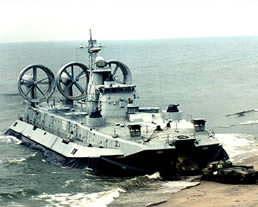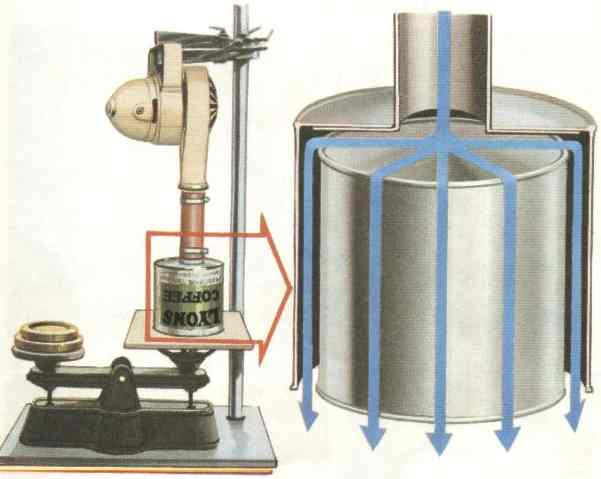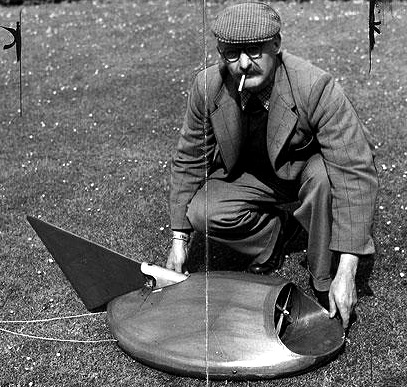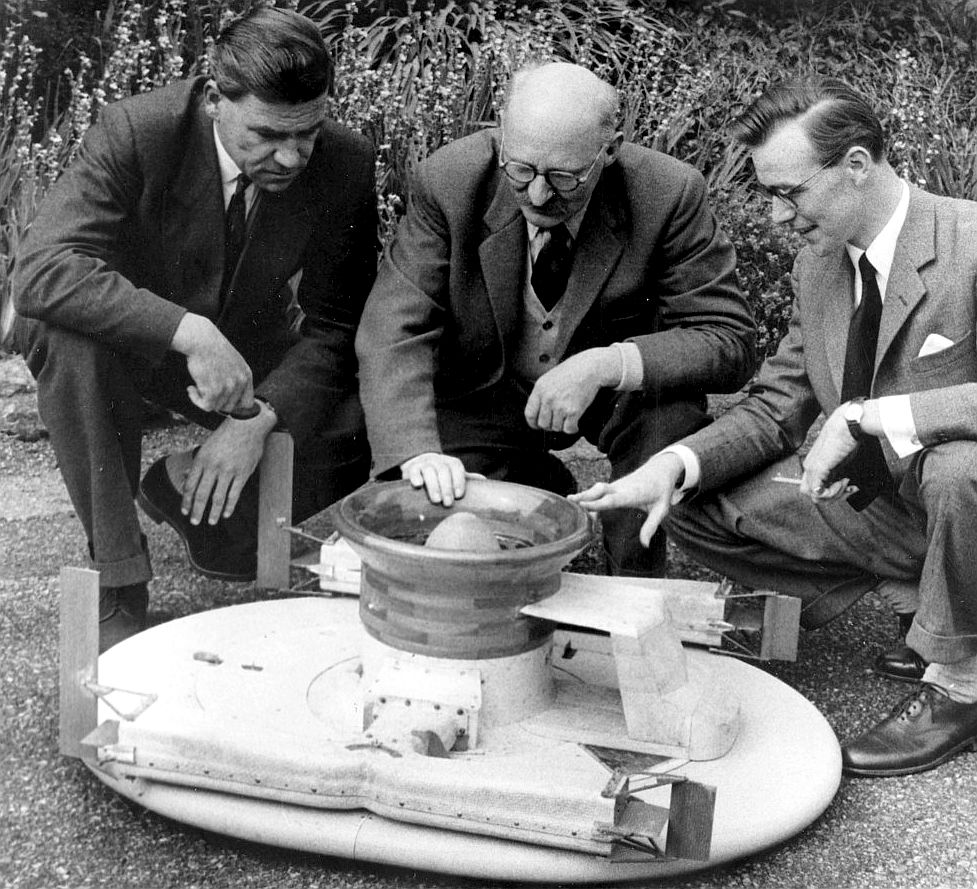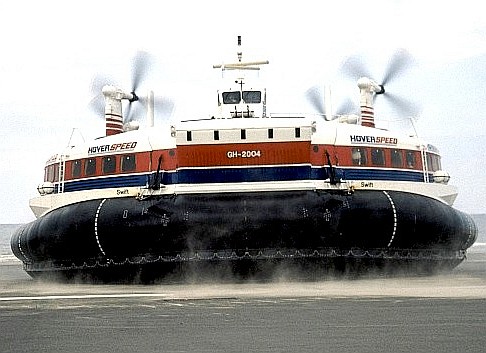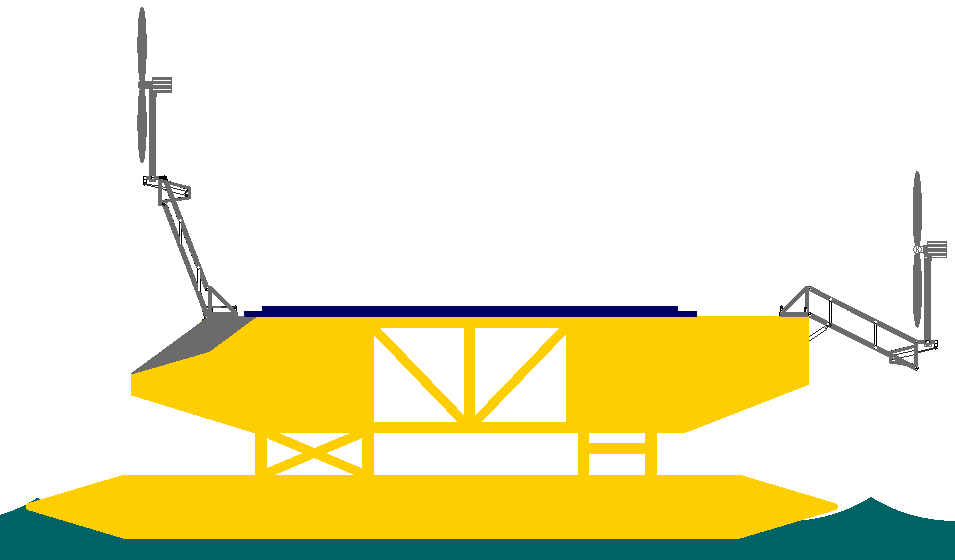|
HOVERCRAFT
|
|
A hovercraft, or air-cushion vehicle (ACV), is a vehicle or craft that can be supported by a cushion of air ejected downwards against a surface close below it, and can in principle travel over any relatively smooth surface, such as gently sloping land, water, or marshland, while having no substantial contact with it.
The first recorded design for a vehicle which could be termed a Hovercraft was in 1716 by Emanuel Swedenborg, a Swedish designer, philosopher and theologian. His man-powered air cushion platform resembled an upside-down boat with a cockpit in the center and manually operated oar-like scoops to push air under the vehicle on each downward stroke. No vehicle was ever built, no doubt because it was realised that human effort could not have generated enough lift.
Hovercraft troop carrier
In the mid-1870s, the British engineer Sir John Isaac Thornycroft built a number of ground effect machine test models based on his idea of using air between the hull of a boat and the water to reduce drag. Although he filed a number of patents involving air-lubricated hulls in 1877, no practical applications were found. Over the years, various other people had tried various methods of using air to reduce the drag on ships.
Col. Melville W. Beardsley (1913-1998), an American inventor and aeronautical engineer, along with Dr. W. Bertelsen worked on developing early ACV's in the USA.
In 1952 the British inventor Christopher Cockerell designed a vehicle based on his 'hovercraft principle'. He was knighted for his services to engineering in 1969. Sir Christopher invented the word 'Hovercraft' to describe his invention.
Cockerell used simple experiments involving a vacuum cleaner motor and two cylindrical cans. He proved the workable principle of a vehicle suspended on a cushion of air blown out under pressure, making the vehicle easily mobile over most surfaces, hence amphibious. The supporting air cushion would enable it to operate over soft mud, water, and marshes and swamps as well as on firm ground.
The British aircraft manufacturer Saunders Roe which had aeronautical expertise developed the first practical man-carrying hovercraft, the SR-N1, which carried out several test programmes in 1959 to 1961 (the first public demonstration in 1959), including a cross-channel run. The SR-N1 was powered by one (piston) engine, driven by expelled air, and could carry little more than its own weight and two men,and did not have any skirt at first trials. It was found that the craft's lift was improved by the addition of a 'skirt' of flexible fabric or rubber around the hovering surface, to contain the air. The skirt was an independent invention made by a Royal Navy officer who worked with Sir Christopher to develop the idea further.
The first true passenger-carrying hovercraft was the Vickers VA-3, which in the summer of 1961 carried passengers regularly along the North Wales Coast from Wallasey to Rhyl. It was powered by two turboprop aero-engines and driven by propellers. During the 1960s Saunders Roe developed several larger designs which could carry passengers, including the SR-N2, which operated across the Solent in 1962 and later the SR-N6, which operated across the Solent from Southsea to Ryde on the Isle of Wight for many years. Operations commenced on 24th July 1965 using the SR-N6 which carried just 38 passengers. Two modern 98 seat AP1-88 hovercraft now ply this route, and over 20 million passengers have used the service as of 2004.
Christopher Cockrell's original experiment 1954
Bell licenced and sold the SRN-5 as the Bell SK-5. There were deployed on trial to the Vietnam War by the Navy as PACV patrol craft in the Mekong Delta where their mobility and speed was unique. Advanced AACVs were developed with automated turrets and slab sides, but use was eventually abandoned. Experience led to the proposed Bell SK-10 which was the basis for the LCAC now deployed.
As well as Saunders Roe and Vickers (which combined in 1966 to form the British Hovercraft Corporation), other commercial craft were developed during the 1960s in the UK by Cushioncraft (part of the Britten-Norman Group) and Hovermarine (the latter being 'sidewall' type hovercraft, where the sides of the hull projected down into the water to trap the cushion of air).
In the late 1960s and early 1970s, Jean Bertin developed a hovercraft train dubbed the Aérotrain in France. His I-80 prototype established the world speed record for overland air cushion vehicles with a mean speed of 417.6 km/h (260 mp/h) and a top speed of 430 km/h (267 mp/h).
By 1970 the largest British hovercraft were in service, the Mountbatten class SR-N4 model, each powered by four Rolls-Royce Proteus engines, regularly carrying cars and passengers across the English Channel from Dover or Ramsgate to Calais. This service ceased in 2000 after years of competition with traditional ferries, catamarans, and the opening of the Channel tunnel.
In 1998, the US Postal Service began using the British built Hoverwork AP.1-88 to haul mail, freight, and passengers from Bethel, Alaska to and from eight small villages along the Kuskokwim River. Bethel is far removed from the Alaska road system, thus making the hovercraft an attractive alternative to the air based delivery methods used prior to introduction of the hovercraft service. Hovercraft service is suspended for several weeks each year while the river is beginning to freeze to minimize damage to the river ice surface. The hovercraft is perfectly able to operate during the freeze-up period, however, it could potentially break the ice creating hazards for the villagers using their snowmobiles for transportation along the river during the early winter.
The commercial success of hovercraft suffered from rapid rises in fuel prices during the late 1960s and 1970s following conflict in the Middle East. Alternative over-water vehicles such as wave-piercing catamarans (marketed as the Seacat in Britain) use less fuel and can perform most of the hovercraft's marine tasks. Although developed elsewhere in the world for both civil and military purposes, except for the Solent Ryde to Southsea crossing, hovercraft disappeared from the coastline of Britain until a range of Griffon Hovercraft were bought by the Royal National Lifeboat Institution.
There are an increasing number of small homebuilt and kit-built hovercraft used for fun and racing purposes, mainly on inland lakes and rivers but also in marshy areas and in some estuaries.
Hovercraft typically have two (or more) separate engines (some craft, such as the SR-N6, have one engine with a drive split through a gearbox). One engine drives the fan (aka the impeller) which is responsible for lifting the vehicle by forcing air under the craft. One or more additional engines are used to provide thrust in order to propel the craft in the desired direction. Some hovercraft utilise ducting to allow one engine to perform both tasks by directing some of the air to the skirt, the rest of the air passing out of the back to push the craft forward.
INVENTION - A popular and fast way to get from Portsmouth to the Isle of Wight was by the Hoverspeed service. Hoverspeed eventually moved from hovercraft into high speed ferries, presumably because the operating costs of such technological marvels was too high. In order to be able to schedule commercial services, the hover craft concept of Christopher Cockerell had to be perfected. The patent declared a secret by the Ministry of Supply, hence preventing disclosure, Cockerell had to wait until 1957 when he heard of a similar invention being developed that overcame military objections, after which he managed to secure funding to develop his invention. The first prototype crossed the English Channel in 1959.
External links
Hovercrafters - A Hovercraft Construction Journal English hovercraft of the 1960s Hovercraft Club of Great Britain Find a personal hovercraft for sale ABS Hovercraft, a major hovercraft designer/manufacturer Hovertecnics pleasure and working Hovercrafts Hovercraft books, models and plans
A CLEAN FUTURE - The Cross Channel Challenger (CCC) is a project currently on the drawing board looking for backing from 2020-21 over 75 weeks, to develop a coastal transport that is zero carbon. Vessels that are green could transform coastal tourism, making it socially acceptable in the face of a planet that will roast unless we do something about it.
This project has been costed to come in at around the £350k mark, hence the vessel does not include the latest lithium batteries or higher output solar cells, nor exotic materials in the build. It is a budget vessel to allow us to start the development ball rolling against a tide of nervous governmental departments looking for miracle solutions at bargain basement rates. The vessel is small for cross channel work, whereas as the length grows, so does the efficiency. Please bear this is mind; things can only get better.
The performance of this concept can be improved significantly by using the latest batteries and bigger wind turbines, allied to computer navigational software to define an efficient course.
|
|
This website is Copyright © 1999 & 2019 MEL. The bird logo and name Solar Navigator are trademarks. All rights reserved. All other trademarks are hereby acknowledged. Max Energy Limited is an educational charity.
|
